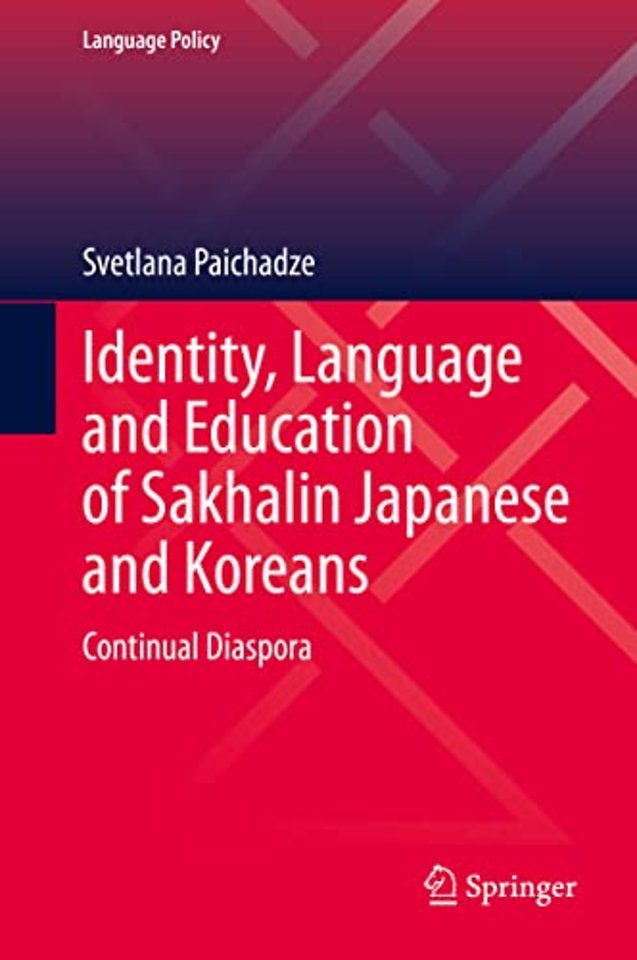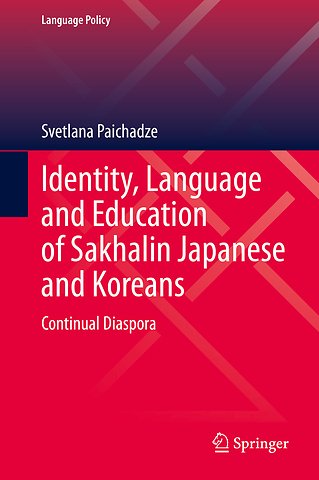Identity, Language and Education of Sakhalin Japanese and Koreans
Continual Diaspora
Samenvatting
This book explores the issues of education, the use of languages and the formation of self-identification of the Japanese and Korean diasporas of Sakhalin, over a hundred years period: from the time they moved to the island, until their “return” to historical homelands in Japan or South Korea. During this time, their language environment and language of education changed 4 times and Japanese and Korean of Sakhalin continued to be a linguistic and ethnic minority.
This book is of interest to researchers, students, NGO supporters and education policy makers.
Specificaties
Inhoudsopgave
<p>1.2 Theoretical Context</p>
<p> 1.2.1 Immigration, Repatriation and Migration Studies</p>
<p> 1.2.2 Diaspora Studies</p>
1.2.3 Ethnic Identity<p></p>
<p> 1.2.4 Identity and Language</p>
1.2.5 School Education and Language<p></p>
1.3 Methodology and Structure of the Book<br></div><div><br></div><div>Part I. From Joint Control to the Border on the Island</div><div><br></div><div>Chapter 2. Sakhalin under Control of the Russian Empire and Soviet Union</div><div><p>2.1 From Joint to Russian Control</p>
<p>2.2 From St. Petersburg Treaty to Russo-Japanese War</p>
2.2.1 Movement of the Population and Ethnic Composition of the Island.<p></p>
<p> 2.2.2 Policy for Migrants in the Russian Far East</p>
2.2.3 First Schools<p></p>
<p>2.3 After Russo-Japanese War </p>
<p> 2.3.1 Movement of the Population </p>
<p> 2.3.2 Schools Between 1906 and 1917</p>
<p>2.4 Sakhalin after the Russian Revolution</p>
2.4.1 New Wave of Colonisation and Migration of the Population<p></p>
<p> 2.4.2 Ethnic Policy in Soviet Sakhalin</p>
2.4.3 Schools in Soviet Sakhalin<p></p>
2.5 Conclusion of the Chapter<br></div><div><br></div><div>Chapter 3. Sakhalin/Karafuto under Control of the Japanese Empire</div><div>3.1 Migration Policy and Movement of the Population to Karafuto<p></p>
<p>3.2 North Sakhalin under Japanese Control</p>
3.2.1 Schools in North Sakhalin<p></p>
<p>3.3 Forced Mobilisation of Koreans</p>
3.4 Minority policy and Interaction between Different Groups of Population<p></p>
<p> 3.4.1 Pre-war Japanese Korean Families</p><p> 3.4.2 Schools and Minority Education in Karafuto</p>
3.5 Conclusion of the Chapter<br></div><div><br></div><div>Part II. Postwar Population Movements</div><div><br></div><div>Chapter 4. Coexistence, Repatriation and Those Left Behind (1945-end of the 1950s)</div><div><br></div><div>4.1 Repatriation of the Japanese Population and the New Ethnic Composition of the Island<br></div><div> <p> 4.1.1 Repatriation and People Left Behind</p>
<p> 4.1.2 Interethnic Marriage </p>
<p>4. 2 Ethnic Policy and Coexistence of Japanese, Korean and Russian schools</p>
<p> 4.2.1 Ethnic Policy</p>
4.2.2 Japanese, Korean, and Russian Schools<p></p>
<p>4.3 Annual Reports on Schools - Sources that Reflect Social Processes Taking Place on Sakhalin</p>
4.3.1 Socio-economic Situation and Education<p></p>
<p> 4.3.2 Ethnic Composition of the Schools</p>
4.3.3 Repatriation<p></p>
<p>4.4 Interviews with the Post-war Young Generation about Their Life, Language Use and School</p>
4.4.1 Reasons to Sstay in Sakhalin<p></p>
<p> 4.4.2 Language in Family Interactions</p>
4.4.3 Socio-economic Situation, Education, and Language at school<p></p>
4.5 Conclusion of the Chapter<br></div><div><br></div><div>Chapter 5. From the End of the 1950s to the end of the 1980s: New Wave of Migration of the Population and the Closure of Korean Schools in Sakhalin</div><div><p>5.1 The new Wave of Repatriation to Japan and Departure to the DPRK</p>
<p>5. 2 Position of Japanese Korean and Korean Schools in Japan</p>
5. 3 Life after Return to Japan<p></p>
<p>5.4 The Closure of Korean Schools on Sakhalin and Russification of the Japanese and Korean Population</p>
5.4.1 Change of the Soviet Language Policy and Closure of the Korean Schools<p></p>
<p> 5.4.2 Language and Identity of Sakhalin Japanese and Koreans after 1963</p>
5.5 Conclusion of the Chapter<br></div><div><br></div><div>Part III: Contemporary Repatriation</div><div><br></div><div>Chapter 6. Contemporary Repatriation to Japan and South Korea: Formation of new diasporas (New Life as Migrants)</div><div>6.1 Life after Returning to Japan and South Korea<p></p>
<p>6.2 Migration and Multicultural Policies in Japan and South Korea</p>
6.2.1 Ethnic Return Migrants as Workers<p></p>
<p> 6.2.2 Multicultural Policy in Japan and South Korea</p>
6.3 Policy for Returnees from Sakhalin<p></p>
<p>6.4 Life, Language Usage and Identity after Return to Japan and South Korea</p>
6.4.1 Language Usage and Identity after Return of First Generation<p></p>
<p> 6.4.2. Language Usage and Identity of Second and Third Generation Returnees</p>
6.5 Conclusion of the Chapter<br></div><div><br></div><div>Chapter 7. Education, Language, and Identity of the Young Generation of Returnees</div><div><br></div><div>7.1 Russian Immigration to Japan and Russian Education<br></div><div> <p> 7.1.1. History of Russian Immigration and Russian Education in Japan</p>
<p> 7.1.2. Russian Community, Russian School and NPOs support in Sapporo</p>
7.1.3. The Ethnic Background of Children at the Russian School in Sapporo<p></p>
<p>7.2. Russian Immigration to Korea and Russian Education</p>
7.2.1. History of Russian Immigration and Russian Education in Korea<p></p>
<p> 7.2.2. Russian Speaking Community and Russian Schools in Ansan</p>
7.3 Identity and Language of Young Returnees<p></p>
<p> 7.3.1 Identity and Language of Young Returnees in Sapporo</p>
7.3.2 The Young Generation of Returnees in Ansan<p></p>
<p>7.4 In Their Own words</p>
7.5 Conclusion of the Chapter<br></div><div><br></div><div>Chapter 8. Conclusions</div><div><p>8.1 History through the Lens of the Human Being, or Man in History</p>
<p>8.2 Identity</p>
<p>8.3 Education</p>
<p>8.4 The Limitation of the Study and Possibility for Further Research</p>
8.5 Summary: some thoughts about Diversity, Identity and Multiculturalism<br></div><div><br></div><div>Appendices</div><div><br></div><div>Index</div></div>

